[

I’m coming up on my first anniversary. It was late August last year when I first baked something like bread and wrote something like a blog post about it.
So how do I celebrate this anniversary? Perhaps by baking some wonderful bread to demonstrate the skill and experience I’ve gathered over the past year? Of course not! That’s would hardly be a meal fit for a glutton for punishment. No, I have to try something new and difficult, to re-live the feeling of utter novice-hood that I remember as if it were just last year.
Croissants and Laminated Pastries!! Something I could study for weeks, work at for days and finish by realizing how very much I have to learn. Sounds like the kind of challenge that got me started baking bread.
I started preparing myself for this experiment by reading everything I could find and watching lots of videos about making lamented dough (yes, I know that word is missing a letter; more about the lamentation later). I was hoping that if I knew the mistakes other people had made, I would only make my own new and novel mistakes (of which I was sure there would be plenty).
Of all the writings on croissants on the World Wide Web, the best by far is Txfarmer’s TFL post about her pursuit of the perfect croissant (http://www.thefreshloaf.com/node/22677/poolish-croissant-pursuit-perfection). I careful reviewed her lengthy and detailed description of all the lessons she learned in repeated attempts. Her account is a perfect example of what makes TFL great. So much work so generously shared, and a wonderful pictorial of a successful course of experimentation. In the process of making the dough and shaping the croissants with the benefit of her numerous tips, I realized that she probably saved my ten pounds of butter worth of inedible (or at least grossly imperfect) croissants.
I made two batches of dough, one Friday for baking Saturday, and one Saturday for baking Sunday. Each batch was split, with some of the dough going into croissants, and some into pastries—morning buns Saturday and pains aux raisins Sunday.
The Morning Bun recipe is here (http://www.7x7.com/recipes/tartines-heavenly-morning-buns-recipe), as cited in Sue’s blog post a couple months ago (http://www.thefreshloaf.com/node/23704/tartine039s-morning-bun-best-eaten-fresh-morning-every-morning). The pains aux raisins recipe is here (http://www.foodnetwork.com/recipes/jacques-torres/croissants-pain-au-chocolat-pain-raisin-and-danish-recipe/index.html).
In general, I found the process challenging but manageable. So many steps, a full weekend is needed, and almost as much patience as butter. I found the dough to be very elastic after the third fold, and never could get it as thin as ¼ inch, even after repeated rests. I also learned on the first batch to be very patient with the proofing…it does take a long while at 70 degrees F. for the pastries to get sufficiently jiggly. The first batch was a bit underproofed, I think.
But, all told, the results were very satisfying, even delectable. The croissants are flaky on the outside, tender on the inside—a wonderful mouthfeel. I slightly oversweetened the morning buns the first time, and will cut back the sugar coating a bit next time The texture of the morning buns is pretty close to the way they should be. Just a bit too heavy and chewy, probably due to underproofing. And the pains aux raisins (which I may re-name “raisins d’etre”) are delightfully tender and delicious, with their almond cream and rum-soaked raisins.
I’m pretty pleased with my first tries at laminated goodies, and grateful to my mentors.
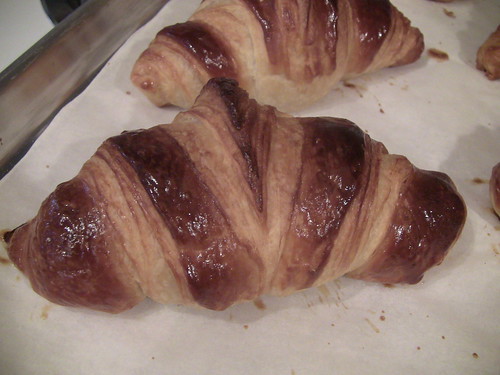
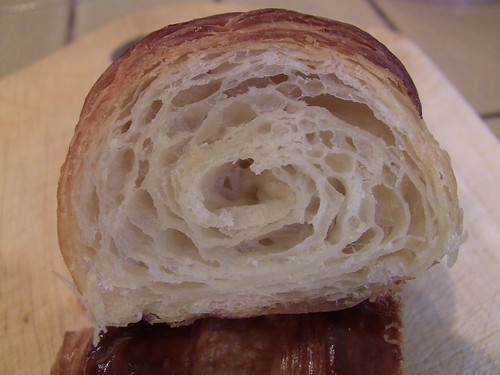
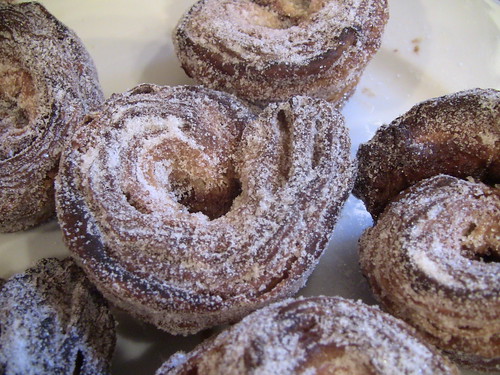
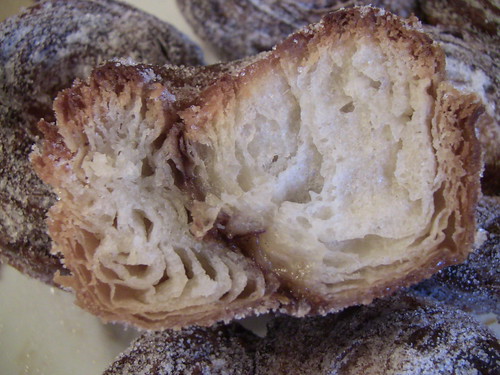
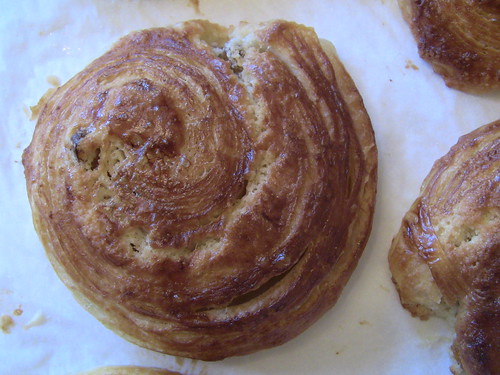
The peak experience was a mid-morning macchiato with warmed pastries. A real morning buzz.

Now, about the lamentation. Yes, I admit I love a good pun almost as much as a bad one. But I really do have a lament about this baking experience. I knew pâtisserie had lots of butter. But, until I saw and dealt with the quantity of butter in this recipe, I hadn’t realized that eating this stuff is basically eating butter and sugar held together with just enough flour and liquid. I imagine if I ate these regularly, someone would need to bash my arteries with a rolling pin (per the proper lamenation technique) just to get the blood to squish past the plaque buildup. I’d end up looking like our local pinniped friends, the elephant seals.

It is simply not fair that something soooo good is soooo bad! Plus, I know that Txfarmer is right that it would take a lot more practice to get really good at it, and of course I have to eat my homework. Plus, today I got an Amazon package with the Tartine cookbook with all their amazing cakes, tarts and pastries. I’m doomed!
So, if I can muster the will power, this will not be a weekly, or even monthly, habit. But I will return to these sinful pleasures on occasion, hopefully when I have a crowd of butter-loving carbotarians around so I don’t need to eat more than one or two myself. Okay…maybe three.
Glenn